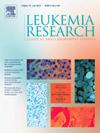Treatment-free remission in chronic myeloid leukemia with rare ABL1 gene fusions: Real-life study from the French CML group Fi-LMC
IF 2.1
4区 医学
Q3 HEMATOLOGY
引用次数: 0
Abstract
Tyrosine kinase inhibitors of the BCR::ABL1 oncoprotein can be stopped without subsequent molecular relapse or major safety concerns in 40–80 % of adult patients with P210BCR::ABL1 positive chronic myeloid leukemia with sustained deep molecular responses. In contrast, ending treatment in patients with rare rearrangements located outside the major BCR region or within the exon 3 of ABL1 remains to be explored. Twenty-four patients with chronic phase disease and diverse uncommon BCR::ABL1 transcripts who obtained sustained molecular residual disease negativity and stopped therapy in a real-life setting for various reasons were retrospectively evaluated for treatment-free remission determinants. Six patients relapsed after a median time of 6 months (range; 3–49), relapse being defined as a rise in molecular residual disease above the 3-log threshold. Treatment-free remission probabilities at 12 and 60 months were 83.3 % (95 % CI: 68.4–98.2 %) and 70.6 % (95 % CI: 49.5–91.6), respectively. The type of BCR::ABL1 transcript was the only relevant baseline factor associated with durable treatment-free remission and patients with fusions lacking exon a2 sequences had the best outcome. To conclude, treatment-free remission is a reasonably achievable goal in patients with rare ABL1 fusion transcripts. Our results pave the way for recommendations in clinical practice. Nevertheless, further research is needed to determine which patients have highest chances to reach deep molecular response levels and become free from therapy and to decipher the biological impact of the different molecular rearrangements of BCR::ABL1 on treatment-free remission.
罕见ABL1基因融合的慢性髓系白血病的无治疗缓解:来自法国CML组Fi-LMC的现实研究
在40 - 80% %的P210BCR::ABL1阳性慢性髓性白血病成年患者中,酪氨酸激酶抑制剂BCR::ABL1癌蛋白可以停止治疗,而不会出现分子复发或主要的安全问题。相比之下,对于位于主要BCR区域之外或ABL1外显子3内的罕见重排患者的终止治疗仍有待探索。24名慢性疾病患者和各种不常见的BCR::ABL1转录本获得持续的分子残留疾病阴性,并在现实生活中因各种原因停止治疗,回顾性评估无治疗缓解决定因素。6例患者在中位时间6个月后复发(范围;3-49),复发被定义为分子残留疾病上升超过3对数阈值。12个月和60个月的无治疗缓解概率分别为83.3 %(95 % CI: 68.4-98.2 %)和70.6 %(95 % CI: 49.5-91.6)。BCR::ABL1转录物的类型是与持久无治疗缓解相关的唯一相关基线因素,缺乏a2外显子序列融合的患者具有最好的结果。总之,对于罕见的ABL1融合转录物患者,无治疗缓解是一个合理的可实现的目标。我们的结果为临床实践的推荐铺平了道路。然而,需要进一步的研究来确定哪些患者最有可能达到深层分子反应水平并摆脱治疗,并破译BCR::ABL1的不同分子重排对无治疗缓解的生物学影响。
本文章由计算机程序翻译,如有差异,请以英文原文为准。
求助全文
约1分钟内获得全文
求助全文
来源期刊

Leukemia research
医学-血液学
CiteScore
4.00
自引率
3.70%
发文量
259
审稿时长
1 months
期刊介绍:
Leukemia Research an international journal which brings comprehensive and current information to all health care professionals involved in basic and applied clinical research in hematological malignancies. The editors encourage the submission of articles relevant to hematological malignancies. The Journal scope includes reporting studies of cellular and molecular biology, genetics, immunology, epidemiology, clinical evaluation, and therapy of these diseases.
 求助内容:
求助内容: 应助结果提醒方式:
应助结果提醒方式:


